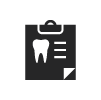Were you aware that the terms overbite and overjet are often used interchangeably? However, they are defined differently. Our dentists in Thornhill discuss the differences between the two and how we might be able to use Invisalign clear aligners to correct either issue.
What are overbites and overjets?
Overbites and overjets are two of the most common orthodontic issues. While people often use these terms interchangeably, there are some important distinctions between the two.
Overbite
Also referred to as a deep bite, an overbite happens when the upper front teeth cover one-third of the lower incisors while your jaw is in a closed position. The nature of this issue is vertical, which differentiates it from the horizontal overjet.
Overjet
Overjet is also known as "buck teeth" and occurs when the upper front teeth jut out over the bottom teeth, which creates a significant horizontal overlap.
While upper front teeth might normally rest slightly in front of your lower teeth when your mouth is closed, any space of more than 2 millimetres will lead to problems.
While overbites are vertical, overjets are horizontal and result in the upper teeth protruding past the bottom teeth at an angle. But with an overbite, the teeth stay downward or straight (not on an angle).
How are overbite and overjet caused?
The most common causes for overbite is that the lower jaw is somewhat smaller than the upper jaw, resulting in the lower teeth resting behind the upper teeth and moving downwards as wear on your teeth takes place.
More gum will tend to show on your upper teeth, and your upper front teeth sit slightly lower than the teeth beside them (upper side teeth, or canines).
Overbites can occur if a patient had a tongue thrusting habit or was permitted to suck on an object - usually a pacifier or thumb - for too long as a child. Biting the nails or chewing on objects such as erasers or pens can also cause this issue.
Similar to overbites, childhood habits such as finger or thumb sucking can cause overjet if they persist when adult teeth begin to emerge. Another common cause is that the lower jawbone (mandible) fails to keep up with the development of the forward growth of the upper jawbone (maxillary). This disparity in growth results in the bottom jawbone (and consequently the teeth), ending up situated behind where they should be for an ideal smile.
Genetic factors can also cause overbite or overjet.
What dental problems can overbite and overjet create?
In extreme cases of overbite, the lower teeth may touch the gum tissue behind the upper front teeth, creating wear on the teeth and gum tissue.
With an overjet, your risk for damaging your teeth or fracturing them increases. Some overjets are barely noticeable as they are moderate, while others are more severe and can make it difficult to close your lips completely due to poor alignment of teeth. You may also notice challenges with chewing or biting.
Can an overbite or overjet be treated with clear aligners?
If the overbite or overjet is skeletal in nature, we would not recommend clear aligners and instead suggest speaking to your dentist to explore other options, such as surgery.
However, if the overjet or overbite is caused by one of the issues listed above, we may be able to treat the problem with clear aligners. The aligners will apply gradual pressure to your teeth to move them into corrected positions as prescribed by your dentist in a custom treatment plan. This will leave you with a straighter, more symmetrical smile.
The clear aligners also move your gum at the same time, keeping proportions in check. You will need to wear your clear aligners for about 22 hours each day, removing them to brush, floss, eat and drink.
Your teeth will progressively shift with the aligners, and you’ll switch to a new set approximately every two weeks. Your custom treatment plan could involve wearing as many as 26 trays, which equates to one tray every two weeks for 12 months.
Before you start your treatment, your dentist will be able to show you a preview of how your new smile will look by the end of your treatment. Take the first step to schedule a consultation with your dentist to learn if you are a candidate for clear aligners.

